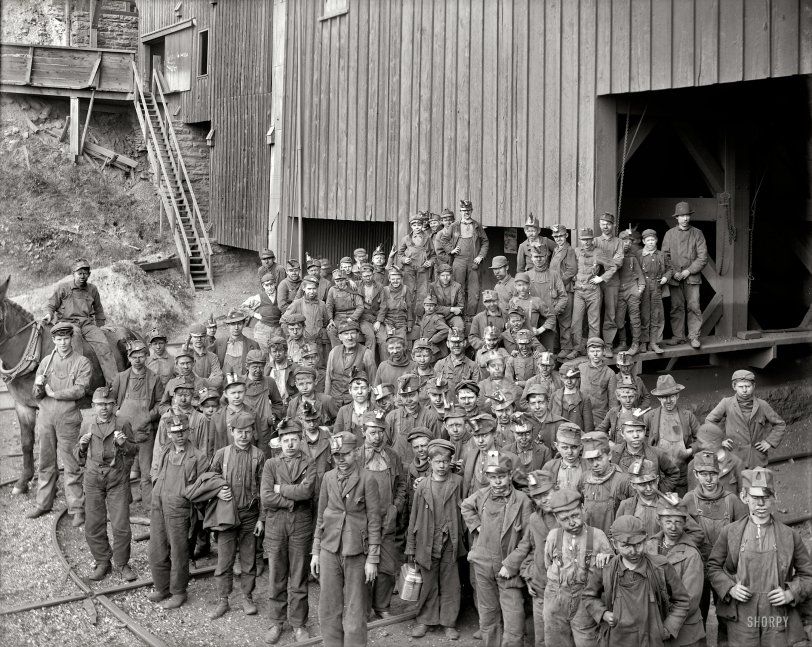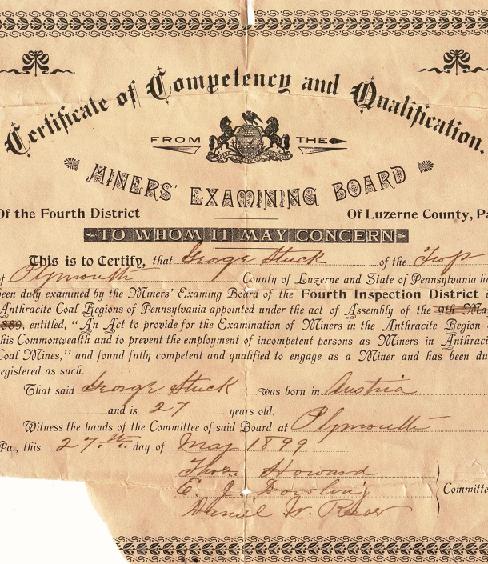


Framed or unframed, desk size to sofa size, printed by us in Arizona and Alabama since 2007. Explore now.
Shorpy is funded by you. Patreon contributors get an ad-free experience.
Learn more.

- Tough Guys
- Lost in Toyland
- And without gloves
- If I were a blindfolded time traveler
- Smoke Consumer Also Cooks
- Oh that stove!
- Possibly still there?
- What?!?
- $100 Reward
- Freeze Frame
- Texas Flyer wanted
- Just a Year Too Soon
- WWII -- Replacing men with women at the railroad crossing.
- Yes, Icing
- You kids drive me nuts!
- NOT An Easy Job
- I wonder
- Just add window boxes
- Icing Platform?
- Indiana Harbor Belt abides
- Freezing haze
- Corrections (for those who care)
- C&NW at Nelson
- Fallen Flags
- A dangerous job made worse
- Water Stop
- Passenger trains have right of way over freights?
- Coal
- Never ceases to amaze me.
- Still chuggin' (in model form)
Print Emporium
Carboniferous: 1900

Kingston, Pennsylvania, circa 1900. "Breaker boys at Woodward coal breaker." 8x10 inch dry plate glass negative, Detroit Publishing Company. View full size.
Caplamps
The caps on these young men have oil wick lamps on them. Carbide lights were just coming on the market and did not become popular with miners, even minor miners, for a few years. I still use carbide for caving and collect the caplamps. A little history of mining lights here.
The Good Old Days
Yes, the socio-political conditions which allowed employment like this to happen are exactly the type of conditions America needs today, yes sir.
Meaning
Puts a whole different spin on the phrase "wasted youth," doesn't it. These lads had no youth to speak of.
Re Hat Rack
Cap lamps are almost probably carbide lamps. Carbide chunks are put in a tight container, a little spit is added, gas forms, a lit match is touched to a small hole and POUF, you can see well enough to dig coal down where the sun never shines. My father, who became a miner at age 12 in 1915, said in the winter months he never saw the sun six days out of seven, going to work when it was dark and coming home in the dark. Years later we used carbide lamps during raccoon hunts. Carbide gas also made a nice explosion if you were to, let's say, add some wet carbide to a paper bag full of cotton waste in, oh, say, the alley behind your grandmother's house in Chicago. drop a match or sparkler on it and run like the wind while you got your pre-teen face to look innocent again. I'm just saying.
Here is my grandfather's (name misspelled; I doubt if he spoke much English so I guess that was close enough) coal mining license from 1899, size greatly reduced, issued, as you see, in Plymouth, Pa., about three miles from Kingston. I've cropped the sides into the text in order to maintain some readability within the 490 pix allowance. My dad's brother Joe was killed at age 20 in a mine by falling rock, a very common accident. I wonder if they knew Shorpy?

A Different Take on the Old Guy
From Wikipedia: "Although breaker boys were primarily children, elderly coal miners who could no longer work in the mines because of age, disease, or accident were also sometimes employed as breaker boys."
His face is pretty clean, so perhaps he was a supervisor. There are a few other older "breaker boys" in the photo, such as the mustachioed gent next to the old guy. Wonder if they were injured miners, or just desperate for work.
The Old Guy
I suspect the old guy was not a breaker boy but a supervisor. Judging by his demeanor I bet he didn't take any guff from any of the boys.
How did this happen?
. . . without Lewis Hine there to tell them not to smile?
A Sea
of faces, some hard some soft, some friendly some fearsome, all dirty.
Dread
I dreaded walking into school every morning of my youth. Imagine having to walk up that narrow flight of stairs into that coal breaker every morning. Scary.
Boys they were!
How did the grizzled old-timer (middle of fourth row from the front) feel about being a "breaker boy," surrounded by youths who weren't even shaving yet?
It's difficult to tell what age this grown man is. Did the boys think of him as just an old, played-out loser, or as a man of experience and wisdom? Or did they see their own future in his face?
All those impish looking boys
and not one set of rabbit ears rising behind someone's head. I'm amazed.
Seriously, that had to be a hard life for these kids.
Paper routes would be better
Breaker boys sometimes had their fingers amputated by the rapidly moving conveyor belts. Others lost feet, hands, arms, and legs as they moved among the machinery and became caught under conveyor belts or in gears. Many were crushed to death, their bodies retrieved from the gears of the machinery by supervisors only at the end of the working day. Others were caught in the rush of coal, and crushed to death or smothered.
Hat Rack
Apologies if you've covered this on an earlier mining photo, but what are the tools attached to their hats? Kind of an interesting place to put them, though I guess it might get in the way less than a hip holster or something.
[Those are lamps. - Dave]
Love the kid in about the middle of the picture with the dramatic, magazine cover model, hand-on-hip pose!
Look out for that 14th step, boys
If they only had OSHA back then.
























On Shorpy:
Today’s Top 5